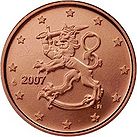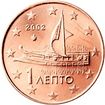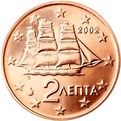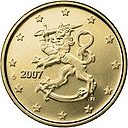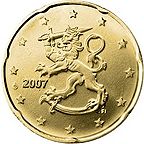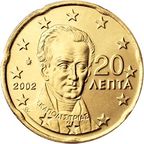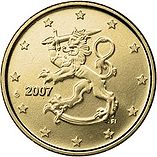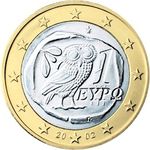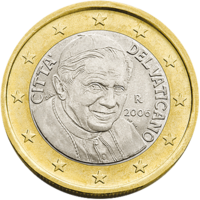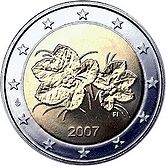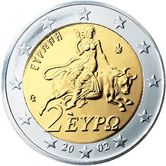Euro coins
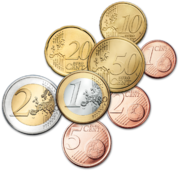
There are eight euro coin denominations, ranging from one cent to two euros (each euro is divided into a hundred cents). The coins first came into use in 2002. They have a common reverse, portraying a map of Europe, but each country in the eurozone has its own design on the obverse, which means that each coin has a variety of different designs in circulation at once.[1] Three European microstates which use the euro as their currency also have the right to mint coins with their own designs on the obverse side.
The coins, and various commemorative coins, are minted at numerous national mints across the European Union to strict national quotas. Obverse designs are chosen nationally, while the reverse and the currency as a whole is managed by the European Central Bank (ECB).
Contents |
Current series
| Common side | National side | Value | Diameter, millimetres |
Thickness, millimetres |
Mass, gram |
Composition | Edge | Design, common side | first minting | |
|---|---|---|---|---|---|---|---|---|---|---|
|
|
€0.01 | 16.25 | 1.67 | 2.30 | Copper plated steel 94.35% steel 5.65% copper |
View of the Earth with Europe, Africa, and the Middle East | 2002 | |||
| Plain edged | ||||||||||
|
|
€0.02 | 18.75 | 1.67 | 3.06 | ||||||
| Has a groove around the edge | ||||||||||
|
|
€0.05 | 21.25 | 1.67 | 3.92 | ||||||
| Plain edged | ||||||||||
|
|
€0.10 | 19.75 | 1.93 | 4.10 | Nordic gold 89% copper 5% aluminium 5% zinc 1% tin |
Europe on the left | 2007 | |||
| Has fine scallops at the edge | ||||||||||
|
|
€0.20 | 22.25 | 2.14 | 5.74 | ||||||
| Seven indents at the edge ("Spanish flower") | ||||||||||
|
|
€0.50 | 24.25 | 2.38 | 7.80 | ||||||
| Has fine scallops at the edge | ||||||||||
.png) |
|
€1 | 23.25 | 2.33 | 7.50 Core: 3.71 |
€1 ring/€2 centre: Nickel brass 75% copper 20% zinc 5% nickel €2 ring/€1 centre: Cupronickel 75% copper 25% nickel clad on nickel core |
Europe on the right | |||
| Interrupted mills (three sections milled, three sections plain) at the edge | ||||||||||
|
|
€2 | 25.75 | 2.20 | 8.50 Core: 4.10 |
||||||
| Embossed letters (different for each country), embedded in mills, all around the edge | ||||||||||
| These images are to scale at 2.5 pixels per millimetre. For table standards, see the coin specification table. Sources: Copper Development Association UK. "The Euro - Born out of Copper". http://www.cda.org.uk/news/euro.htm. Retrieved 2007-05-29. Sources: European Central Bank. "ECB:Common sides". http://www.ecb.eu/bc/euro/coins/common/html/index.en.html. Retrieved 2007-11-23. |
||||||||||
Common side
All coins have a common reverse side showing how much the coin is worth, with a design by Belgian designer Luc Luycx.[1] The design of the 1-, 2-, and 5-cent coins symbolises Europe's place in the world as a whole.
Current design
In 2007, a new design was introduced to reflect the enlargement in 2004. The design still retains all elements of the original designs, including the twelve stars, however the map of the fifteen states is replaced by one showing the whole of Europe 'as a continent' without borders. The vertical ridges only appear over the 'sea'.
Cyprus is shown several hundred kilometres north west of its real position in order to include it on the map. On the €1 and €2 coins, the island is shown to be directly east of mainland Greece; on the 10-, 20-, and 50-cent coins, it appears directly below Crete. The original proposal from the European Commission was to include Turkey on the map, however this design was rejected by the Council.
The first issue of these coins were minted in 2006, by the Mint of Finland, for the Slovenian euro coins. These coins came into circulation in 2007 and are compulsory for existing members to issue from 2008 onwards. The one-, two-, and five-cent coins remained unchanged, with the Commission stating that they remained unaffected as they show Europe's place in the world, even though the EU 15 are still highlighted on the map. It is unknown how soon Iceland would be added to the map if it becomes an EU member in the next few years.
1999–2006 design
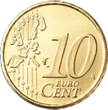
€0.10
|

€0.20
|
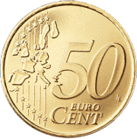
€0.50
|

€1.00
|
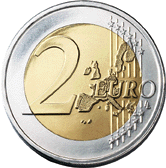
€2.00
|
The original designs of the 10-, 20-, and 50-cent coins showed the outline of each of the EU-15 member states. This meant that each state was shown as separate from the others, though, thus giving Europe an appearance of being formed of many islands. EU members which were not part of the Eurozone (the United Kingdom, Sweden, and Denmark) were also depicted.
On the €1 and €2 coins, the landmass appeared more cohesive although borders were indicated. The vertical ridges also passed through some non-participating countries. As in current issues, all coins featured 12 stars in their design.
The year featured in the coins can date back to 1999, when the currency was formally established (only Belgian, Finnish, French, Dutch, and Spanish coins print 1999). These countries traditionally put on the coin the year when it was minted rather than the year in which it was put into circulation.
National sides
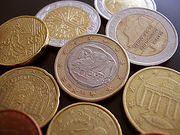
The obverse side varies from state to state, with each member allowed to choose their own design. Each of the eight coins can have the same design (such as Belgian coins), or can vary from each coin (such as Italian coins). In monarchies, the national side usually features a portrait of the country's monarch, often in a design carried over from the former currency (such as Belgian coins). Republics tend to feature national monuments, symbols, or stylised designs (such as French coins). Engravings on the edge of the €2 coin are also subject to national choice.[2]
There are, however, some restrictions on the design: it must include twelve stars, the engraver's initials, and the year of issue. New issues must also include the name of the issuing country. It can't repeat the denomination of the coin or the word euro unless it is in a different alphabet (such as on Greek coins).[2] The national side is also restricted from changing until the end of 2008, unless a monarch depicted on a coin dies or abdicates (such as in the case of the Vatican's coins). Following 2004, states could also produce one €2 commemorative coin a year in limited numbers.[3]
There are at present no plans to abolish the national designs in favour of a European one. However the Commission has proposed that the one-, two-, and five-cent coins have a common design to keep costs down.[4] Also, in 2007, all Eurozone countries issued a near-identical commemorative coin to celebrate the 50th anniversary of the signature of the Treaties of Rome. These coins had the same design except for the name of the country and the language of the text used.
Though they are not members of the EU, Monaco, San Marino, and the Vatican City also have euro coins featuring a national side, but these only occasionally end up in general circulation as their scarcity leads to greater interest from coin collectors. Andorra is currently in talks to mint its own coin design.
Future changes to national sides
"The national sides of all denominations of the euro circulation coins should bear an indication of the issuing Member State by means of the Member State’s name or an abbreviation of it."
"The national side should not repeat any indication on the denomination, or any parts thereof, of the coin neither should it repeat the name of the single currency or of its subdivision, unless such indication stems from the use of a different alphabet."
"This Recommendation should apply to national sides and edge letterings of both normal and commemorative euro circulation coins. It should not apply to the national sides and edge letterings of both normal and commemorative euro circulation coins which have been first issued prior to the adoption of this Recommendation."
The above paragraphs, in essence, requires 5 of the Eurozone members to change their national designs. Finland was the first state when they changed its design in 2007, Belgium did so in 2008 while Austria or Germany will not change their current design for the time being.[5] Greece is still pending.
Small-denomination coins
.png)
.png)
The one- and two-cent coins were initially introduced in order to ensure that the introduction of the euro was not used as an excuse by retailers to heavily round up prices. However, due to the cost of maintaining a circulation of low-value coins, by business and the mints, Finland and the Netherlands round prices to the nearest five cents (Swedish rounding) if paying with cash money, while producing only a handful of those coins for collectors, rather than general circulation.[6] Despite this, the coins are still legal tender and produced outside these states, so if a customer with a one-cent coin minted elsewhere wishes to pay with it, he may.[7]
The Swedish rounding law in Finland was issued in January 2002—before the coins were put into circulation. The Netherlands followed suit in September 2004, with Belgium making moves to follow in 2005.[7] The Netherlands did so under pressure from retail businesses, who have claimed that dealing with 1- and 2-cent coins is too expensive. After a successful experiment in the city of Woerden in May 2004, retailers in the whole of the Netherlands have been permitted to round cash transactions to the nearest five-cent amount since September 2004.[8]
This is in part due to factors such as rising metal prices: De Nederlandsche Bank calculated it would save $36 million a year by not using the smaller coins. Other countries such as Germany favoured retaining the coins due to their desire for €1.99 prices, which appear more attractive to the consumer than a €2 price.[7] This is echoed by the European Central Bank itself which support the coins stating it allows businesses to calculate prices more exactly to attract consumers, such as 99 cents.[9] According to a Eurobarometer survey of EU citizens, Germans are most sceptical about the removal of the one- and two-cent coins from complete circulation in the Eurozone, however on average there is a majority for their removal (58% for the one-cent coin and 52% for the two-cent coin in 2005). The Belgians are most supportive of their removal.[10]
The 1-, 2-, and 5-cent coins account for approximately 80% of all new coins minted in the Eurozone. Due to the expense of producing such low-value coinage, the Commission with some member states have proposed that costs could be cut by having a common design on both sides of these coins, rather than minting numerous different designs.[4]
Features for persons with impaired sight
.jpg)
showing their unique edges.
Euro coins were designed in cooperation with organisations representing blind persons, and as a result they incorporate many features allowing them to be distinguished by touch alone. In addition, their visual appearance is designed to make them easy to tell apart for persons who cannot read the actual inscriptions on the coins.
The coins increase in size and weight with value. Of the eight denominations of euro coins, the three lowest denominations are small and distinctly reddish in colour, and quite thin and light. The next three denominations are yellow in colour and thicker, as well as heavier. The highest two denominations are each of two different colours, and are generally larger and thicker than the lower denominations.
In general, the greater the value, the heavier the coin; and the greater the value, the larger the coin. Reddish colour identifies low values; yellow colour identifies medium values; two different colours identify high values.
- The €0.01 is the smallest of all coins, and size is probably the best way to identify the coin. Its diameter is about the size of the thumb-nail of an average adult. The edge of the coin is smooth, and the coin is copper in colour.
- The €0.02 is slightly larger than the one-cent coin and is of the same copper colour. It incorporates a distinctive groove running circumferentially around the edge of the coin; this groove can be felt easily by running the finger tip or a fingernail across the edge of the coin; the groove gives the visual and tactile impression that it consists of two coins pressed into one, though this is not the case.
- The €0.05 is also copper in colour, and is the largest of the copper coins, but only slightly larger than the two-cent coin. It has a smooth edge.
- The €0.10 is gold in colour. It is very slightly smaller than a five-cent piece, but it is much thicker, and it has a coarse serration around the edge. It is heavier than any of the copper coins.
- The €0.20 is larger than the ten-cent coin and is also gold in colour. It has a unique group of seven notches (forming a spanish flower shape) around its otherwise-smooth edge, making it easy to recognise by touch.
- The €0.50 is also gold in colour and is noticeably thicker, heavier, and larger than the coins of smaller denominations, and it also has a coarsely serrated edge.
- The €1 has a silver coloured interior and a gold coloured perimeter. The edge is distinctively marked with alternating smooth and finely serrated sections. It is of about the same thickness and weight as the fifty-cent piece, but its edge markings readily distinguish it from that coin.
- The €2 is of the same colours as the one-euro coin, but they are reversed: the perimeter is silver coloured, and the interior is gold coloured. It has the largest diameter of any euro coin. Its edge has a fine, continuous serration. The edge is also embossed with stars and letters differing between nations, but this is difficult to detect by touch, and may not be necessary in order to distinguish it from other coins, given its size.
Although there have been other currencies predating the euro that were specifically designed in similar ways (different sizes, colours, and ridges) to aid the visually impaired, the introduction of the euro constitutes the first time that authorities have consulted associations representing the blind before, rather than after, the release of the currency.
Counterfeit coins
Approximately 100,000 counterfeit euro coins are taken from circulation annually, and a similar number are seized before they can be released. Given a total circulation of 56 billion coins, counterfeit coins are relatively rare. About half the counterfeits feature the German national design, but counterfeits have been detected featuring all issuing countries' designs. The great majority of counterfeit coins are €2 (87% in 2004), with most of the rest being €1, and a few 50-cent coins.
Seized coins from circulation (totals):
- 2009 – 172,100[11]
- 2008 – 195,900[11]
- 2007 – 211,100[12]
- 2006 – 163,800[12]
- 2005 – 100,500[12]
- 2004 – 75,564
- 2003 – 26,339[13]
The European Technical and Scientific Centre estimates that up to two million counterfeit coins were put into circulation in 2002.[14]
Recent investigations by the European Commission have shown that the level of sophistication in the counterfeits is increasing, making prompt detection even more difficult.[15] An Irish MEP Eoin Ryan called for tighter regulation over tokens and medals that are being increasingly used for small purchases mainly in vending machines across Europe.[16]
Commemorative issues
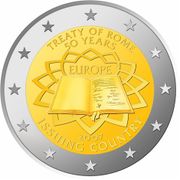
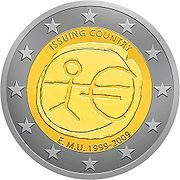
Each state allowed to issue coins may also mint one commemorative coin each year. Only €2 coins may be used in this way (for them to be legal tender) and there is a limit on the number that can be issued. The coin must show the normal design criteria, such as the twelve stars, the year and the issuing country.
Greece was the first country to issue a commemorative coin, and was followed by all but Cyprus, the Netherlands, Ireland, and Malta. However, in 2007 every Eurozone state participated in the Treaty of Rome programme, where all member states issued a coin of similar design to commemorate the signing of the Treaty of Rome (the only difference being the name of the issuing country and the language of the text).
This was repeated in 2009 in commemoration of the 10th anniversary of the introduction of the euro. The design was selected by electronic voting by EU citizens.
Also, since 2006, Germany has been issuing a series of coins, the German Bundesländer series, showing each of the states of Germany on its coins between 2006 and 2021. Common programmes such as the Treaty of Rome and euro anniversary do not count as a state's yearly issue.
Gold and silver commemorative issues
A legacy of old national practice is the minting of silver and gold commemorative coins. Unlike normal issues, these coins are not legal tender in all the Eurozone, but only in the country where the coin was issued. For instance, a €10 Finnish commemorative coin cannot be used in Portugal.
Despite this, these coins are not really intended to be used as means of payment, as the bullion value of the gold coins generally vastly exceeds their face value, so it does not constitute a serious problem. Many silver coins however, like German €10 commemoratives, are often available at banks and some retailers at face value. The coins, however, generally do not circulate.
It is uncertain whether the Council of Ministers will grant them legal tender status elsewhere outside national boundaries, as San Marino, Monaco, and the Vatican City also issue these kind of coins.
References
- Notes
- ↑ 1.0 1.1 Euro coins. European Central Bank.
- ↑ 2.0 2.1 Common guidelines: the national sides of euro coins, Europa (web portal)
- ↑ Changes to the national sides of euro coins, Europa (web portal)
- ↑ 4.0 4.1 Five years of Euro banknotes and coins, Europa (web portal) 2007-01-17
- ↑ "No design change for Austrian and German euro coins (in German)". Press release. 2008-02-01. http://www.zwei-euro.com/2-euro/. Retrieved 2008-02-01.
- ↑ Save the penny or leave the penny?, CBC News 2007-10-10
- ↑ 7.0 7.1 7.2 Small Change, Big Annoyance in Europe, Business Week 2004-09-23
- ↑ Castle, Stephen (September 16, 2004). "Smallest Euro coins dropped by two nations". Independent, The (London). http://findarticles.com/p/articles/mi_qn4158/is_20040916/ai_n12808602. Retrieved 2008-07-15.
- ↑ What is the benefit of issuing low-denomination (1 and 2-cent) coins?, European Central Bank
- ↑ The euro, 4 years after the introduction of the banknotes and coins (PDF), Eurobarometer 2005
- ↑ 11.0 11.1 http://europa.eu/rapid/pressReleasesAction.do?reference=MEMO/10/2
- ↑ 12.0 12.1 12.2 http://europa.eu/rapid/pressReleasesAction.do?reference=MEMO/08/10
- ↑ The euro counterfeit coins withdrawn from circulation in 2006.
- ↑ European Technical & Scientific Centre. Activity in 2002 European Commission. European Anti-Fraud Office
- ↑ "'Most sophisticated' fake euro coin network uncovered in Italy". http://www.eux.tv/article.aspx?articleId=20053.
- ↑ Euro Coins need protection Last retrieved 01-12-08
External links
- European Central Bank
- The Euro - Information Website
- Common guidelines for the national sides of euro circulation coins
|
||||||||||||||||||||||||||||||||||||||||||||||||||||


